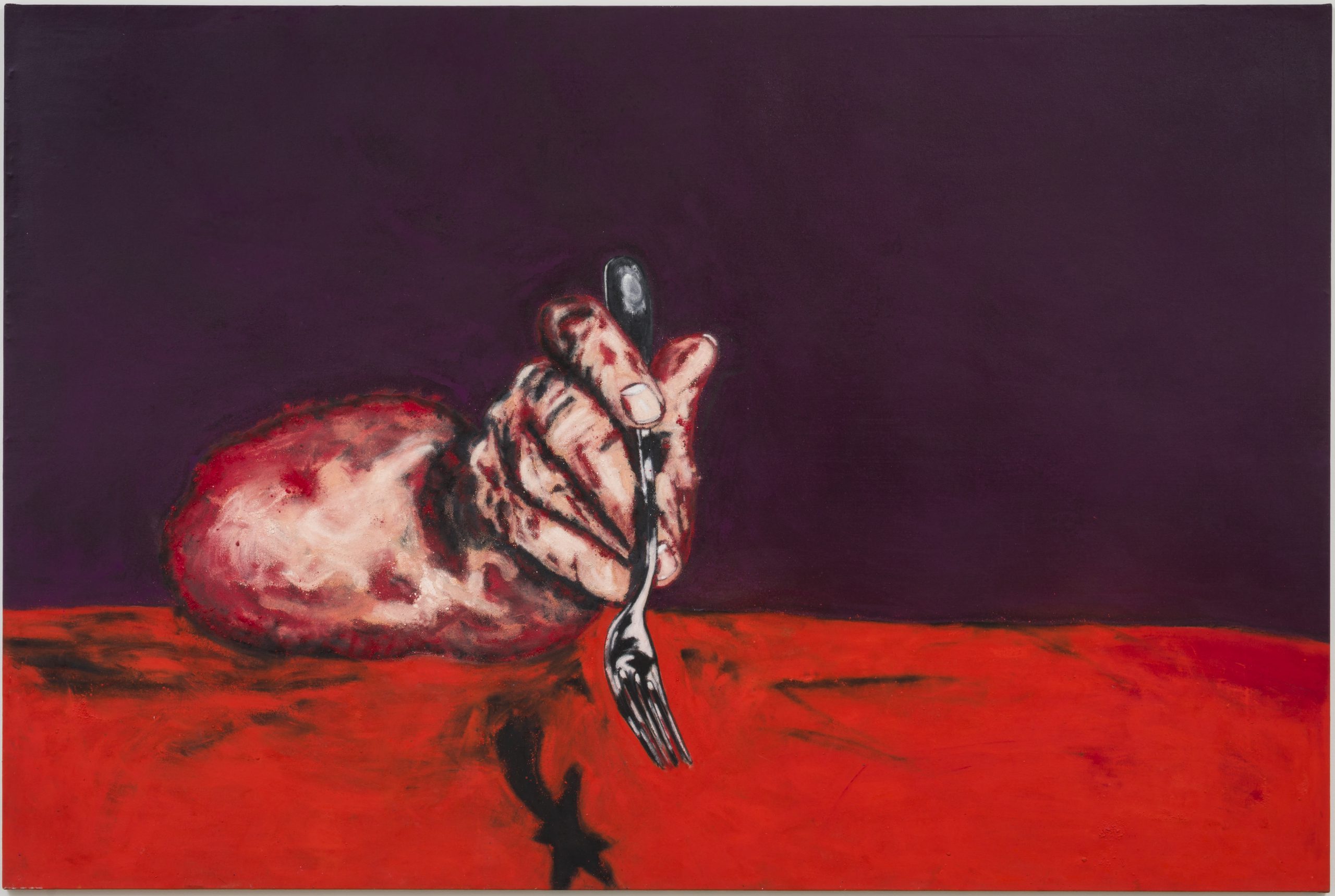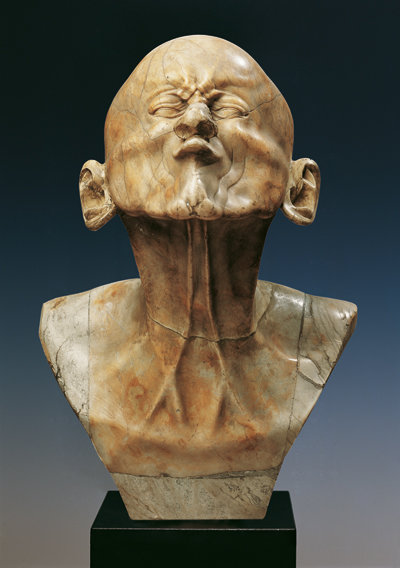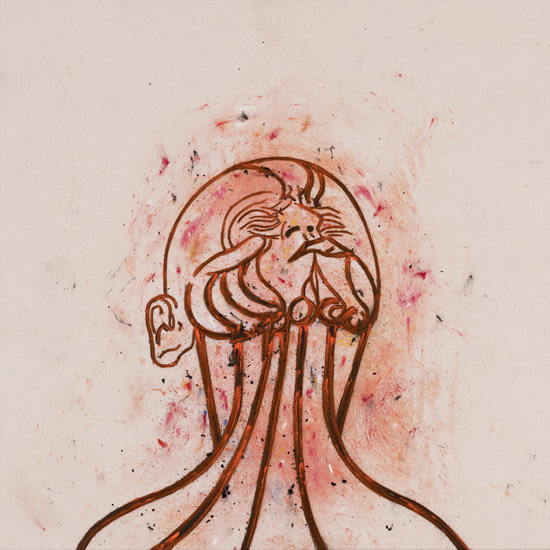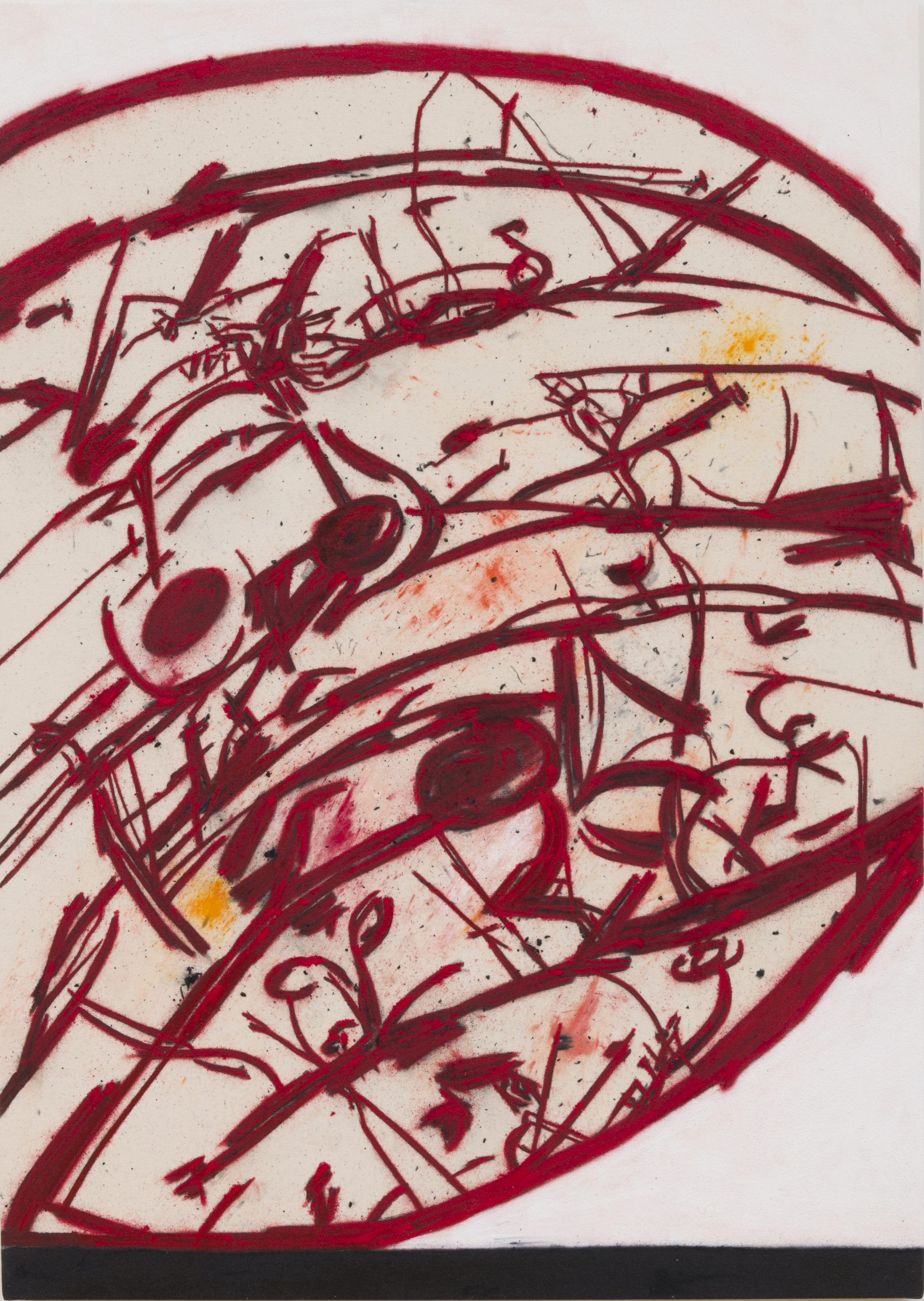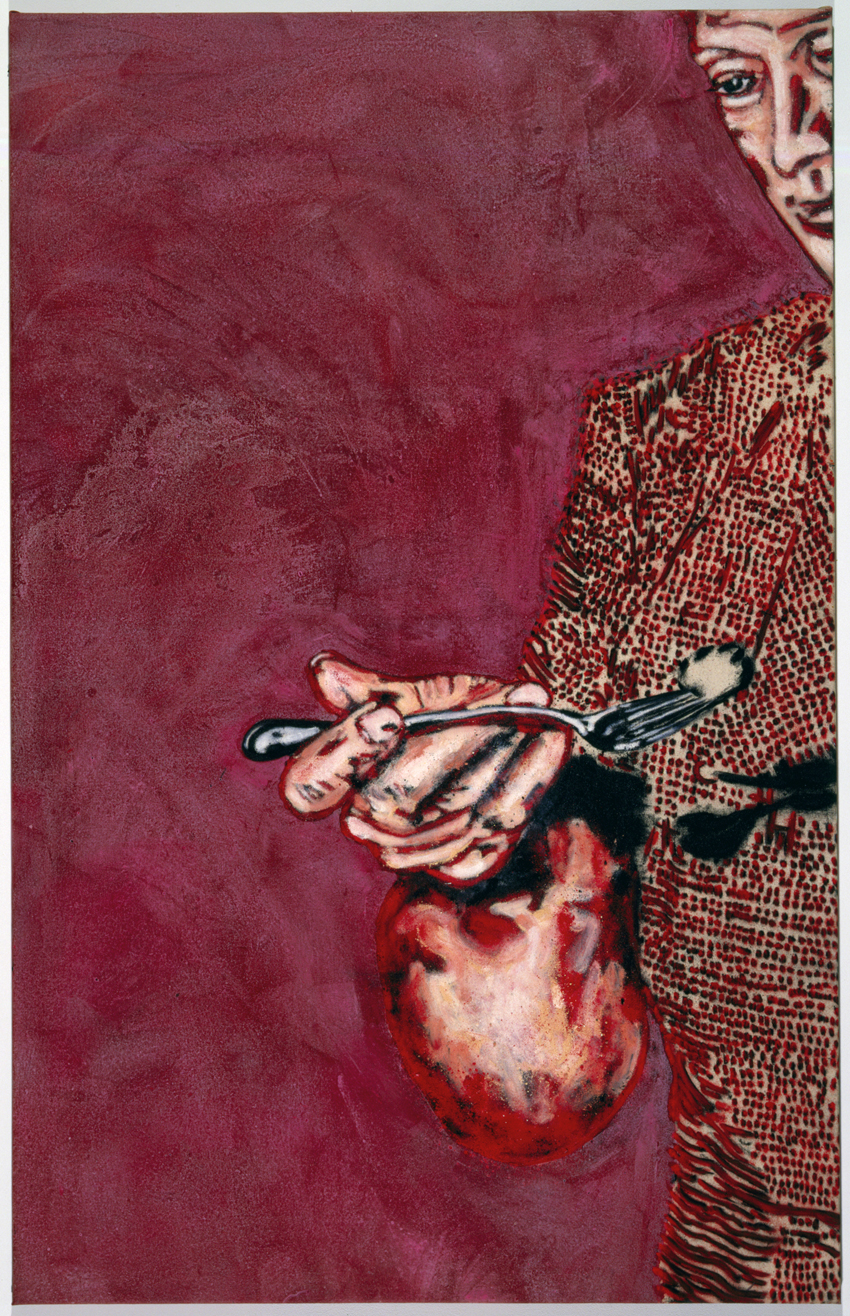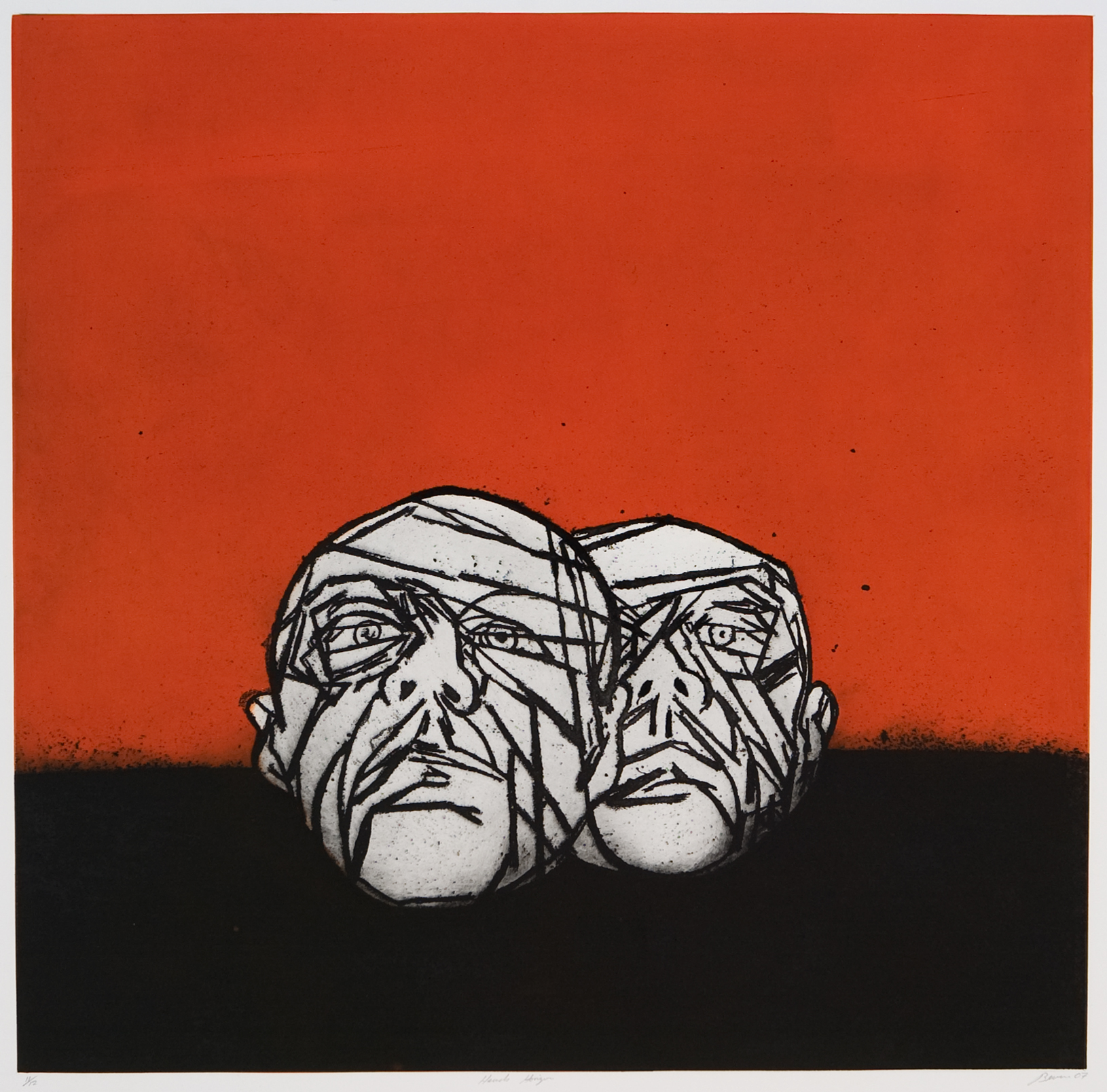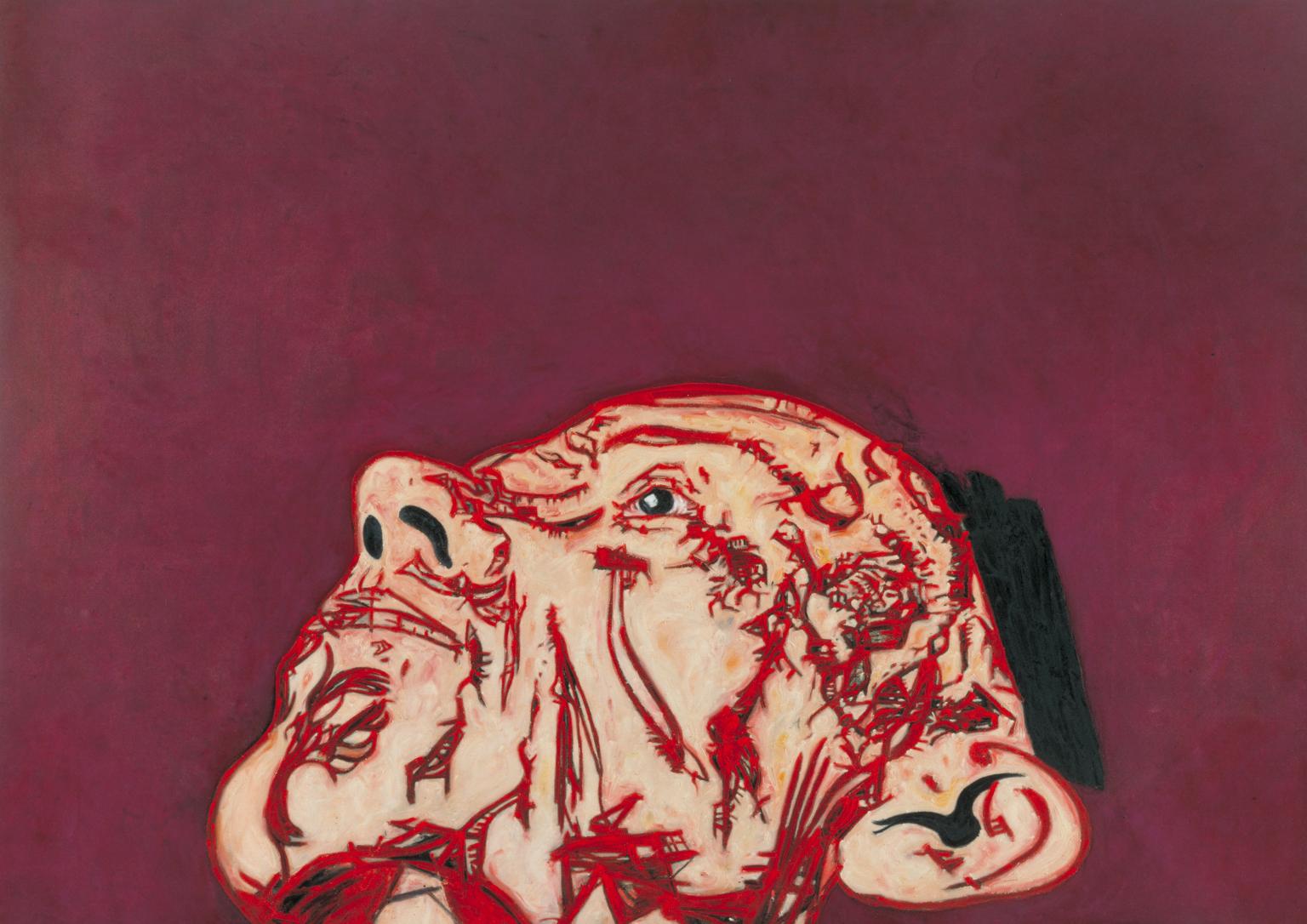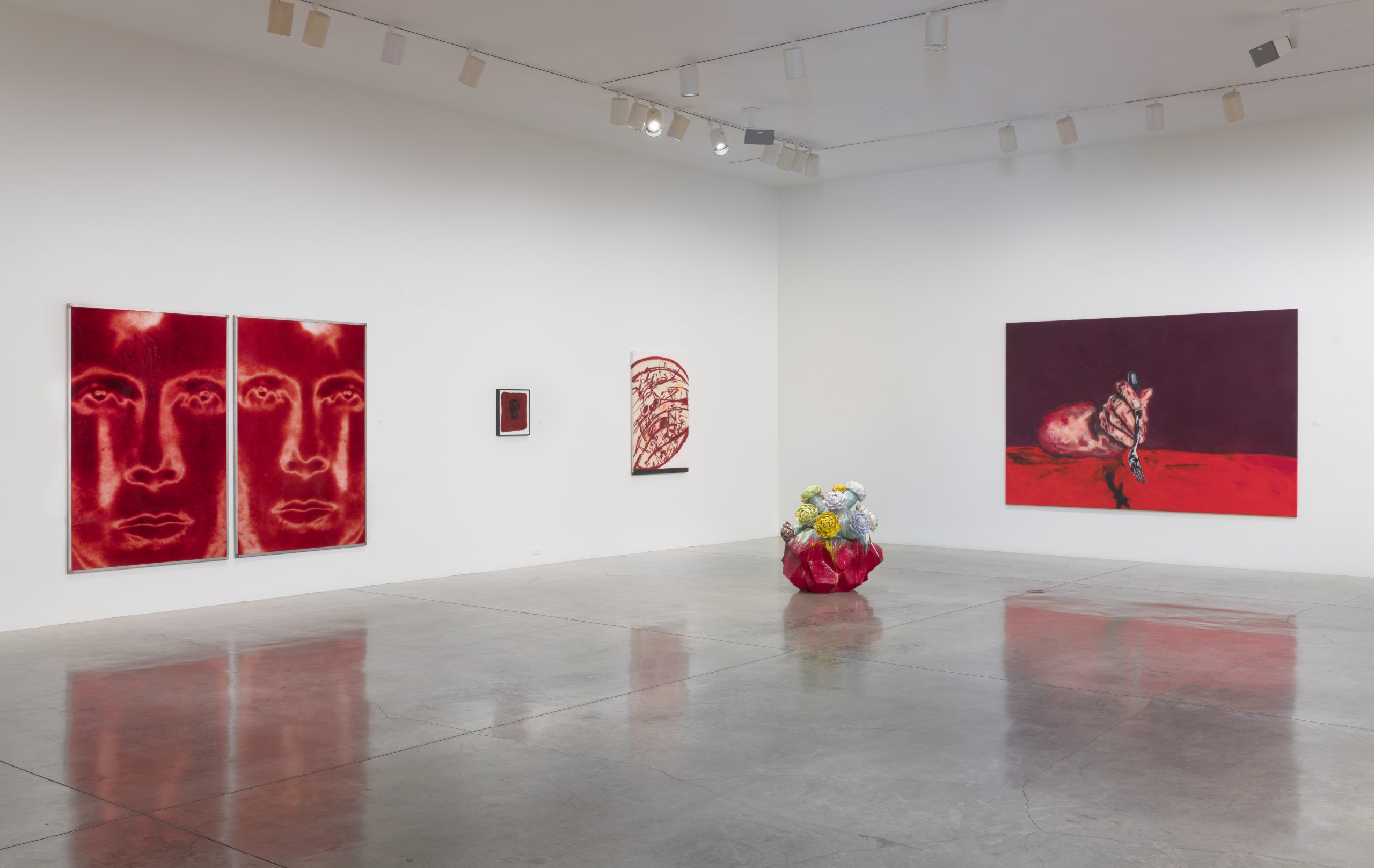
The Tony Bevan (b. 1951, British) works on display in RED – Fork (1989) and Head (2005) – provide perhaps the most potent example of how truly unnerving the exhibition’s titular color can be. Created sixteen years apart, the paintings each engage with a subject Bevan has pursued with relentless focus throughout his career, namely the isolated, abstracted, even disembodied human figure.
Tony Bevan
Fork, 1989
acrylic on canvas
77 x 115 in. (195.6 x 292.1 cm)
signed, titled, and dated verso
Inquire
Often associated with the School of London, a loose configuration of British painters working figuratively at a time when critical attention fixated almost exclusively on Minimalism and conceptual art, Bevan has drawn a wide range of artistic comparisons, including the likes of Francis Bacon, Antonin Artaud, and Samuel Beckett, as well as historic painters like Mantegna, Géricault, and F.X. Messerschmidt, on whom Bevan wrote his graduate thesis. Yet Bevan, reluctant to concede clear, direct references and meanings to his work, stands out from these artists in a few critical ways.
One of these is his limited range of his motifs. Over the course of his decades-long career, Bevan has devoted himself to an almost excessively restrained set of overlapping themes. These include: architectural spaces – particularly corridors and rafters; furniture; tabletop still-lifes, monumentalized to the scale of the cityscapes; and, as noted, the human body, beginning as a concern with the entire figure and progressing to an almost singular focus on the head. Head, on display in this exhibition, typifies Bevan’s exploration of this latter subject matter. As with many of his head works, we see here an almost fully abstracted form, decipherable as a head via a limited number of gestures signaling eyes, a nose, and, possibly, a mouth, all within a tilting circular head shape. To these limited signs, Bevan adds an almost architectural scaffold of red lines. Often interpreted by critics as scars or wounds, these lines are described by the artist as ‘flow patterns,’ evidence of his exploratory movements through what he calls the “internal landscape” of the head.
Tony Bevan
Head, 2005
acrylic and charcoal on canvas
51 1/2 x 36 5/8 in. (131 x 93 cm)
signed verso
Inquire
These disordered markings, suggestive of the psychological disquietude of his figures, also hint at Bevan’s modes of working which, like his subject matter, channel meaning through the body. Setting his unstretched canvases on the floor and crawling on all fours, Bevan bears down on his implements, grinding splintering charcoal styluses and nearly shorn brushes laden with acrylic into his canvases. The resulting piled-up shards of debris jut out from the finished work in gritty bas-relief, while imprints of the artist’s feet, hands and knees often muddy the representational space and ground. The physicality of this process is central to the works’ meaning, connecting Bevan’s body to the final product, a connection which nonetheless exists through his works’ almost exclusive concern with an abstracted form of self-portraiture. Bevan works almost entirely from his own image, reflected back at him through studio mirrors and photography. Yet we should be careful not to ascribe too much particularity to these images. As one critic writes, “Bevan’s self-portraits advance an inescapable paradox. With his own presence as a primary subject, a process of relentless scrutiny has resulted in progressive abstraction. The closer he has drawn to his own image, the more it has assumed an autonomous character, almost taking on a separate existence."
This notion of separate existence is on plain view in Fork, in which a grisly, disembodied arm, fork in hand, reaches toward the space of the viewer across a red-clothed table. As in Bevan’s Head, this work is part of a thematic cycle of more-or-less abstracted works that, in this case, incudes paintings like Once (1989) and Arm and Red Table (1989). In Fork, as in these other works, we again see Bevan’s concern with the isolated human figure. Yet we also see the artist’s interest in the foreshortened form, his typically monumental scale, and the raw, sumptuous color palette – characterized by earthy tones of ox-blood, ochre, and cobalt – for which he has become known. With its void-like background and blocky horizontal table, Fork's compositional structure also suggests Bevan’s larger oeuvre, which often displays a singular figure or figures against an abstracted horizon (see Heads Horizon, 2007, and Head, 1995). In Fork, these disparate elements coalesce into a work of striking visceral unease, the fragmented arm, as Dan Cameron describes, “frozen, a strange emblem of hope and forlornness hovering in perpetual expectancy.”
Tony Bevan
Once (PC896), 1989
powdered pigment and acrylic on canvas
77 x 49 in. (195.6 x 124.5 cm)
Private collection.
Tony Bevan
Arm and Red Table (1989)
acrylic and pigment on linen
58.2 x 55.9 in. (148 x 142 cm)
Private collection, England.
Tony Bevan
Heads Horizon, 2007
etching
image: 31 x 31 7/8 in. (79 x 81 cm)
paper: 41 x 41 in. (104.1 x 104.1 cm)
edition of 12
What Fork and Head share – and what is common throughout Bevan’s body of work – is this almost extreme form of psychological tension. Yet, as Cameron’s statement above suggests, the work maintains ambiguity, never tipping into outright horror or madness. In Head, for instance, the swirling tumult of gestural lines contrasts with the almost calm stillness of the eyes, while the blood-red fleshy musculature of Fork suggests both anguish and vitality. Through these contradictions, the works in RED exemplify Bevan’s oeuvre; indeed, as one writer describes, “over and above its exploration of loneliness and suffering, his work ends up affirming the fundamental will to survive.” This will is ever-present, simmering just below the surface of Bevan’s paintings, which would be mistakenly read as simply sinister. Subjected to, but not overcome by torment, Bevan’s figures – such as those in Head and Fork – embody the painful, yet ultimately optimistic Beckettian struggle, declaring resolutely to us, the viewers: “I can’t go on, I’ll go on.”
Installation of RED at L.A. Louver.
Photograph by Robert Wedemeyer, 2023.
References:
Klaus Ottman, “Painting Heads,” in Tony Bevan, Institut Valencià d’Art Modern, Valencia, 2005, p. 52.
“Tony Bevan in Conversation with Michael Peppiatt,” in Tony Bevan: New Paintings, Ben Brown Fine Arts, London, 2008, p. 38.
Hubbard, Sue, “Tony Bevan,” in Tony Bevan: New Paintings, Ben Brown Fine Arts, London, 2008, p. 8.
Moorehouse, Paul, “His Finite Body: Tony Bevan’s Self-Portraits,” in Tony Bevan: Self-Portraits, National Portrait Gallery, London, 2011, p. 21-22.
Dan Cameron, “Internal Skin,” in Tony Bevan, Louver Gallery New York, New York, 1991, p. 8.
Cork, Richard, “In Extremis: Bevan and the Western Tradition,” in Tony Bevan: Paintings and Drawings, London: Michael Hue-Williams Fine Art, 2000, p. 19.

